Looking for ways to get rid of gnats! No worries you are at the right place.
Gnats are often known as “nats” or “knats“. Gnats are small-sized flies ranging in size from 1/8″ to 1/10” in length. They have two wings and in terms of appearance, they resemble more to a mosquito than to a fly.
As per Wikipedia, “A gnat is any of many species of tiny flying insects in the Dipterid suborder Nematocera, especially those in the families’ Mycetophilidae, Anisopodidae and Sciaridae “.
Gnats are nuisance pests because they just lay eggs, annoy people, spread diseases, and die. Gnats are weak fliers but they torment people and become quite a distraction in the workplace.
Most species of gnats are attracted to carbon-dioxide just like horseflies and this is the reason you always find them flying around your mouth and nose.
In this article, we are going to see how to get rid of gnats, but before that let’s have a look at different types of gnats.
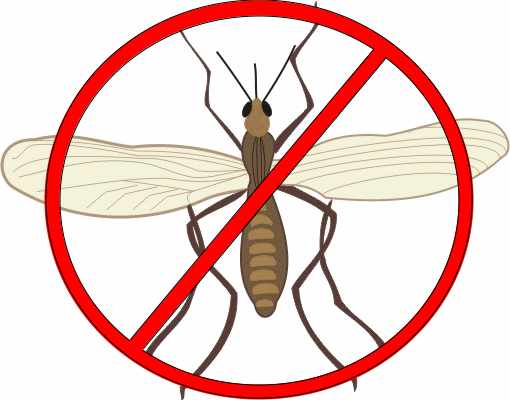
Types of Gnats:
As we have already told that gnat is not a single species of flying insect, hence there are multiple types of gnats:
Fungus Gnats or Winter Gnats:
Fungus gnats are also called as winter gnats. As the name suggests these types of gnats are associated with microscopic fungi. And hence they thrive in a damp and decaying environment where fungi can grow.
Fungus gnats are attracted to light and this is the reason why you mostly see them flying near windows.
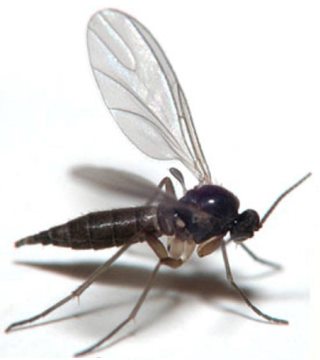
Habitat:
Fungus gnats are often found at places where humidity levels are quite high. The most common habitat for fungus gnats is ordinary houseplants where the soil is overwatered or the water cannot drain properly.
This creates a favorable environment for the gnats to thrive and feed on the decaying matter. Other possible breeding sources may include moisture conditions created by roof leaks or any other plumbing leaks.
Recommended Reading: Best ways to get rid of house flies
Lifecycle of a Fungus Gnat:
The lifecycle of a fungus gnat can be divided into four stages – egg, larva, pupa, and adult. Female fungus gnats deposit their eggs on the moist soil or decaying matter. These eggs hatch into larvae in about three days.
The larvae feed on the decaying organic matter, but in some species, they also feed on the plant roots. Fully developed larvae (after about 10 days) then undergo a pupae stage. This pupae stage spans approximately 3 days. After about 4 more days in the pupae stage, adult fungus gnats emerge.
Damages:
- They cause annoyance to humans.
- Some species of fungus gnats in larval stages feed on plant roots, which causes diminished growth in plants.
Eye Gnats or Grass Flies or Eye flies:
Eye gnats are known by many different names like Grass Flies, Eye Files, etc. But they all belong to the ‘Chloropidae’ family of flies.
Eye gnats are very small flies that are attracted to fluids secreted by the eyes, nose, and ears in both humans and animals. And because of this these files are known to transmit eye diseases and conditions such as acute conjunctivitis (pink eye).
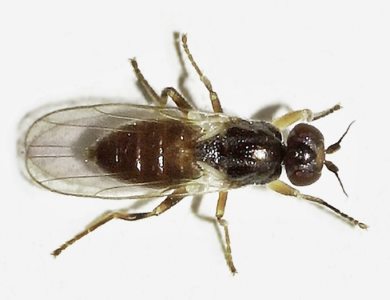
Habitat:
They prefer to live in areas with loose sandy soil but can thrive in many environments.
Lifecycle of an Eye Gnat:
The lifecycle of an eye gnat is also divided into four stages. It takes 3 weeks from the development of an egg to the emergence of an adult during the summer season.
Female eye gnats lay eggs below the surface of loose soil. These eggs are pearlescent white and approximately 0.5 mm long. Eggs hatch into larvae in about 7 – 10 days. Larvae are 3 mm in length and are whitish in color. They feed on organic matter.
After full development larvae undergo the pupae stage. The pupae are just about 2.25 mm in length and reddish-brown in color. After about 7 days in the pupae stage, adult eye gnats emerge.
Damages:
- Eye Gnats are known to spread disease-causing organisms like – Streptococcal skin infection bacteria, vesicular stomatitis virus (rabies virus).
- As they are attracted by eye fluids and hence they transmit eye diseases like acute conjunctivitis.
Buffalo Gnats or Black Flies:
Buffalo gnats are also known as black flies. These gnats are named so because of their humpbacked appearance. They are small-sized with a size of one-eighth of an inch. They typically appear in late spring and early summer.
Buffalo gnats (mostly females) swarm around birds, animals, humans and bite them to fulfill their protein needs. Males mostly feed on nectar and do not bite humans. Whereas female buffalo gnats feed on blood in order to get enough protein to produce eggs.
These gnats are attracted to carbon dioxide, perspiration, and dark moving objects, this way they can identify their prey.
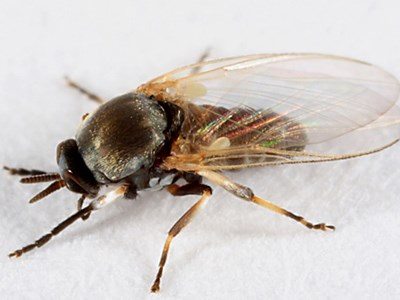
Habitat:
Buffalo gnats are mostly found near lakes or streams because they prefer to lay their eggs near clean, fast-running water. Adult gnats can fly up to 10 miles in search of blood, but mostly they don’t have to do this, as they can easily find easy prey near the water sources.
Lifecycle of Buffalo Gnats:
Buffalo gnats have a unique lifecycle. Female buffalo gnats lay several hundred eggs in running water streams. These eggs are yellow or orange in color. The eggs develop in running water and hatching can take from 4 -30 days.
When they develop into larvae, they find a stable surface to rest on. They have a suction cup-like small structure, attached to their abdomen that allows them to stick to such surfaces. Larvae are brown, gray in color with a light brown head.
Larvae then feed on other smaller organisms or organic matter and in about two weeks undergo the pupae stage. Pupation takes place on stones or other stable objects in the water. Pupae period is 6 – 8 days after which adult emerges. Adult floats to the surface in a bubble of air and quickly flies away. Buffalo gnats typically live for three weeks.
Damages:
- They bite humans and animals to draw blood from them.
- The bites are painful and often cause an allergic reaction, causing them to swell and itch.
- They also cause river blindness.
Sand Gnats or Sand Flies:
We have a separate article on these types of gnats. You can read it here.
Do Gnats bite?
If you are facing a gnat infestation then the answer to this question must be very important for you. But actually, there is no easy answer to this question.
As it totally depends on the type of gnat, some gnats like Fungus Gnats and Eyes Gnats do not bite. But there are others like Buffalo gnats and Sand Gnats which can bite and their bite is very painful.
In the following section, I am going to tell you how you can identify a gnat. After which you can decide whether your home or surroundings are infested by biting or non – biting gnats.
Recommended Reading: Do gnats really bite?
How to Identify Different Species of Gnats:
You can use the following table to identify different types of gnats:
| Features | Fungus Gnat | Eye Gnat | Buffalo Gnat | Sand Gnat |
|---|---|---|---|---|
| Image | 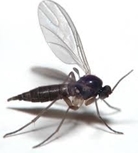 | 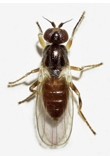 | 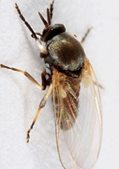 | 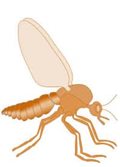 |
| Size | 2 – 5 mm in Length | 1.5 – 3.5 mm in Length | 2 – 5 mm in Length | 1.5 – 5 mm in Length |
| Physical Appearance | They have blackish-grey bodies with long gangly legs, multi-segmented antennae. | They have shiny black or gray bodies and yellow to orange-brown legs. | They have black or greyish bodies, shiny thorax, short legs, and clear wings without scales. | Yellowish or brownish in color with hair all over their head, thorax, abdomen, and legs. |
| Special Features | Attracted to light | Attracted to eyes | Humpbacked appearance | Hairy wings in vertical ‘V’ shape |
| Biting / Non-Biting | Non-Biting | Non-Biting | Biting | Biting |
Now, after identifying that which gnat has infested your surroundings, you can proceed to the next step (i.e. gnat removal).
Recommended Reading: How to get rid of flies Indoors and Outdoors
How to Get Rid of Gnats:
For ease of understanding and implementation we have divided the process of getting rid of gnats into two steps:
Stage 1 – Gnat Control Techniques: In this step, we are going to understand how to control the fungus gnat population by cleaning or rather destroying their breeding sources. This will help to control any further growth of gnats.
Stage 2 – Gnat Removal Techniques: Now, after destroying the breeding sites of the gnats, we will be left only with adult gnats. Since they now have no place to lay eggs, so the gnat problem will get solved by eliminating them.
Recommended Reading: Learn how to get rid of fruit flies easily
Gnat Control Techniques:
In this step, we will see how to get rid of gnats by destroying their breeding sources. Let’s see the steps involved in this method:
Step 1 – Identification:
This is the most important step in the process because if this goes wrong all your efforts in getting rid of gnats are going to prove futile.
In this step, you have to use the above identification table and identify which type of gnat has infested your surroundings.
Step 2 – Find their breeding source:
After you have identified the gnat type, you can search for their breeding sources near your house. In the following section, I will highlight the breeding sources of different types of gnats.
| Gnat Type | Breeding Source |
|---|---|
| Fungus Gnats | – Overwatered Soil with organic matter |
| – Area with water leaks or drainage problems | |
| – Swelled wall coverings, peeling paint due to moisture | |
| Eye Gnats | – Moist, well-drained sandy soils with abundant organic matter. |
| – Date gardens, citrus groves, crop fields, golf courses, flower beds, etc | |
| – Decaying weeds, leaf litter, and grass clippings, or drying organic matter and compost piles. | |
| Buffalo Gnats | – Rivers, streams, lakes, or any other running water source. |
| Sand Gnats | – Dry dark area having not too cold but humid weather. |
| – Hollow trees, dead lead litter, animal burrows. |
 Now, using this table search the breeding source or any similar area for the gnat you have identified earlier in Step 1.
Now, using this table search the breeding source or any similar area for the gnat you have identified earlier in Step 1.
Please note that generally the breeding sources of gnats can be located up to 100 – 800 meters away from the place of infestation. But in some cases, (for example: in the case of Buffalo flies) it could be located up to 10 km away from the infested site.
Note: This may be the most time-consuming step of the whole process, but please do not skip this.
Step 3: Destroy the breeding source:
After you have identified the breeding source, you can go ahead and destroy it.
If the source is overwatered soil in a pot, stop watering the soil till the top layer (3 – 4 inches) becomes dry. Or cover the soil with a thick 2-inch layer of coarse sand.
 If the breeding source is outside, wash the area with a disinfectant made from 10% Clorox and water. And after that, sprinkle some borax over the area.
If the breeding source is outside, wash the area with a disinfectant made from 10% Clorox and water. And after that, sprinkle some borax over the area.
If it is near some garbage can, then sprinkle some borax powder in the cans regularly and make sure to clean them at least twice a week. And make sure to seal the garbage cans with tight-fitting lids.
Try to keep the breeding site clean and dry.
Why Borax?
Borax is scientifically known as sodium tetraborate. It is formed from boric acid and sodium salts.
And when these two chemicals are mixed together they work as a pesticide against a number of insects like gnats and flies.
Note: Unfortunately, these chemicals (boric acid and sodium salts) also work as herbicides, so I won’t suggest you use them around your plants.
Step 4 – Wait for 1 or 2 months:
 Using the above steps, you will prevent new generations of gnats from reproducing in your area.
Using the above steps, you will prevent new generations of gnats from reproducing in your area.
This will stop the further growth of gnats in the area.
But then, you must use some other methods to kill individual adult gnats that you may come across in the next 30 – 45 days (because this is the maximum lifespan of an adult gnat).
Gnat Removal Techniques:
In this section, we are going to see of the quickfire ways to eradicate gnats. Also, for the sake of simplicity, we have classified these methods into 5 major categories. You can pick any method from any category to see if it works in your case or not. The categories are as follows:
Category 1 -Traps:
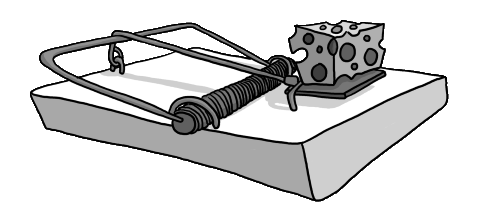
1. Apple cider vinegar Trap:
Most gnats are naturally attracted to the smell of apple cider vinegar. To make an apple cider vinegar trap you will need the following:
- Small bowl or jar with a lid
- Apple cider vinegar (In absence of apple cider vinegar you can also use white vinegar)
- Dish soap
Take the jar and put some 10 – 20 ml of apple cider vinegar in it. Add 5 – 8 drops of dish soap (preferably lemon-scented). Stir the mixture so that the dish soap mixes well with the vinegar. After this, make some small holes in the lid, the holes should be of about 0.5cm in diameter. Now put the lid on the jar and place the trap at the infested place.
Gnats will get attracted by the smell of apple cider vinegar and will try to reach into the jar through the holes in the lid. When they try to sit over the surface of the solution they get drowned. This is because due to the addition of dish soap the surface tension of the solution is greatly reduced.
2. Wine and Dish soap trap:
Gnats are also attracted to red wine, so you can use this trap if you have some leftover wine. To make this trap you will need:
- A small container or a glass
- Dish soap
- Some red wine
- A piece of cardboard
Take the container and pour the leftover wine into it. Next, put 3-5 drops of dish soap into it. Stir the mixture so that the dish soap mixes well with the wine. After this, make some 0.5 cm holes in the cardboard piece and put it over the container. As soon as the gnats smell the solution they will try to enter the container.
But as I have already told that dish soap will reduce the surface tension of the solution hence they will get drowned in the liquid.
3. Buffalo Gnat Trap:
As we know that buffalo flies get attracted to dark moving objects. So, in this trap, we are going to use the same fact against them.
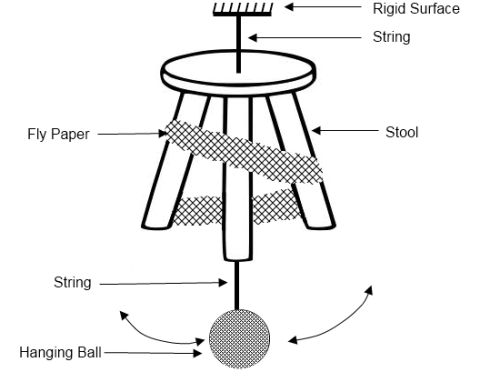
To make this trap you will need:
- A tough string.
- A dark-colored medium-sized ball or you can also paint any ball with black color.
- Flypaper (commercial or homemade)
- A stool
To make the trap, tie the dark-colored ball to the string. Next tie the open end of the string with the bottom of the stool. After this, wrap the flypaper over the legs of the stool. Hang the stool in the infested area.
Every few hours, just push the ball so that it keeps swinging in the air. The swinging motion of the dark ball will attract the buffalo gnats. When they come near the trap, they will try to land over it and get stuck in the flypaper.
Recommended Reading: Homemade fly traps
4. Egg Bait Trap for Eye Gnats:
This trap is particularly effective against eye gnats. You could use this trap outdoors and it’s going to emit a nasty smell. To make this trap you will need the following:
- Multiple 1-liter plastic bottles
- 1-gallon container
- 4 eggs
Crack four eggs in the 1-gallon container and add fill the container with water. Mix the contents thoroughly. Fill the 1-liter bottles to about 1/4 with the solution. Immediately save the remaining solution in the refrigerator.
Punch some 5 – 10 holes in the bottle and hang these bottles 3 – 5 feet from the ground in your garden. Check the bottles every 1 week and you will find loads of dead eye gnats inside the bottle.
Change the mixture in the bottles every 15 days.
5. UV Light Bug Zapper:
Some people have suggested that bug zappers that emit UV light are particularly effective against most species of gnats both biting as well as non-biting species.
You just have to install the zapper, switch it ‘On’ and it is ready to defend you against gnats. You can check out this one at Amazon.
6. Disposable Gnat traps:
Disposable fly traps are generally effective against most of the fly types. These disposable fly traps contain some attractant which is in a dormant state. When you fill these traps with water the attractant gets activated.
The attractant then starts emitting a strong incense that gnats and other flies cannot resist. They try to enter the trap but the construction of the trap is such that once an insect enters inside, it cannot leave and finally gets drowned.
I have written an article on the disposable traps that you can read here.
Category 2 – Repellent:
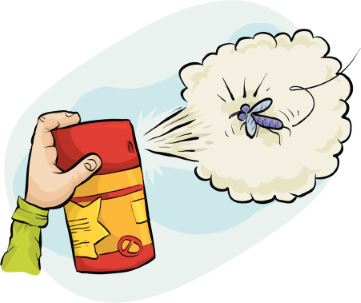
7. Vanilla Repellent:
Gnats hate the smell of Vanilla. You can apply vanilla repellent over the exposed areas of your body to make sure they are not attacked by gnats.
To make the repellent, you need to buy pure vanilla extract from the market. Make sure that the vanilla extract that you have brought is sugarless. After this take 10 ml of vanilla extract and mix it with 10 ml of water.
Stir the solution so that the vanilla and water get mixed properly. Then dip a cotton ball in the solution and apply the mixture over the exposed areas of your body using the cotton ball.
Note: Please note that high concentrations of vanilla may cause skin irritation. Also, some please are allergic to vanilla so it is better to test the solution by applying it in small quantity over the skin before using it actually.
8. Citronella oil Spray:
Citronella oil is one of the few things that gnats and other breeds of flies hate the most. You can prepare a spray from Citronella oil that you can use to deter gnats.
To make the spray you need:
- An empty spray bottle
- Citronella oil
- Dish soap
To make the spray, mix two cups of water with two spoons of the oil add 3 – 6 drops of dish soap. Pour the mixture into the spray bottle and you are ready with your own anti-gnat natural spray.
You can spray this mixture around your home, near your plants, or near garbage cans. The best thing about the mixture is that it is harmless for your pets or plants and on top of it will leave a pleasant citrus-like smell around your home.
9. Diluted Rubbing alcohol spray:
Gnats quickly die when they come in contact with diluted rubbing alcohol. You can pour some diluted rubbing alcohol into a spray bottle. Spray whenever you see a gnat and watch them dying instantly.
10. Lemon Oil:
If you find gnats inside your home or kitchen, then this is the best repellent for them. You can buy lemon oil and an essential oil diffuser to both deter gnats and also add a citrusy freshness to your home.
11. Repellent Gnat Fly DEET-Free:
This repellent is particularly effective against biting buffalo gnats. It is made from natural ingredients and uses a no alcohol formula. It contains ingredients like vanilla, mint, and rose scent.
You can check it on Amazon where a good number of people have given it a decent rating with many positive reviews.
Category 3 – Chemical Methods:

12. DEET Insect Repellent:
DEET repellents are the best and most effective means to get rid of gnats. The bad part about them is that they can cause health issues if used in high concentration for a long period of time. But nevertheless, they can protect you from different types of insects like biting flies, gnats, chiggers, ticks, and fleas.
Check it out on Amazon to buy this at a special price.
13. DEET Pump Spray:
This is another very effective DEET pump spray from Repel. It has 40% DEET content that helps to deter flies for almost 8 hours. It repels mosquitoes, ticks, gnats, biting flies, chiggers, and fleas.
This product has many positive reviews and a very good customer rating on Amazon.
14. NON-DEET Gnat Repellent Spray:
This is a revolutionary anti gnat spray made entirely from natural ingredients. You can use it on your kids and don’t have to worry about any itching, rashes, or stinky smell. It repels gnats, mosquitoes, ticks, chiggers, sand flies, fire ants, and fleas.
As per the claims made by the manufacturer this product has the active ingredient ‘Geraniol’ which is twice as strong as DEET and completely safe as per the FDA.
Check out Amazon to get a heavy discount for this product.
15. Ammonia to Kill Gnats in Drains:
If the source of gnats in your kitchen is your kitchen sink drain then this is the method that you should go for. Pour around 200 – 230 ml of ammonia inside your drain. This will damage the breathing tubes of the larvae and kill the adult ones.
As ammonia is toxic to humans, so ensure that you leave the ammonia to dilute for several hours before using the sink again. In absence of ammonia, you can also use diluted bleach as few people had success in using bleach instead of ammonia.
Note: Ammonia has a foul smell and is toxic to humans so use it carefully. Make sure to wear eye and mouth protection while working with Ammonia.
16. Insect Foggers:
Foggers are probably the best solution when you are trying to deal with an acute gnat infestation. They produce a dense fog that permeates foliage, cracks, and other hiding places, reducing the gnat population. It is effective against gnats, mosquitoes, flies, and moths.
Category 4 – Biological Methods:

17. Beneficial Nematodes:
Beneficial nematodes are microscopic roundworms that act as parasites. Once installed, they search for fungus gnat larvae fleas, and other soil-borne pests penetrate them and then release some bacteria inside their bodies that consume the pest from inside out.
It should be noted that they do not harm people, pets, plants, or earthworms. They are safe to use and once installed they can work for as long as 18 months.
18. IGR for Gnats:
IGR stands for insect growth regulators. These are some of the best biological methods to effectively reduce the insect population.
IGR’s are chemically synthesized hormones that interfere with the normal lifecycle of an insect. When an insect grows, it undergoes a process called molting. During this process, the insect grows a new exoskeleton under its existing one and then sheds the existing one to grow further.
IGR’s prevent the insects from reaching maturity by interfering with the molting process. And because of this insect never reaches the adult phase and hence is unable to reproduce and hence it reduces the population of the insect drastically.
Fortunately, in the markets, we have IGR’s that work for most species of gnats. You can check them out here.
Category 5 – Miscellaneous Methods:

19. Vacuuming Adult Gnats:
Yes, it may sound like a simple tip but scientists have confirmed that vacuuming gnats in any stage (from Adult to Eggs) can have success rates as high as 96%. This is really simple as you just have to switch on your vacuum and point the nozzle towards these pesky monsters.
20. Citronella candles:
As we already know that gnats hate Citronella oil, and hence you can use Citronella candles to keep gnats at a bay if you are planning to have an outdoor picnic.
21. Tobacco Layer:
Many people have experienced success by covering the soil with a thin layer of tobacco to repel fungus gnats. To use this method all you need to do it to take 3-4 cigarettes, break them, and cover the soil with a thin layer of tobacco. This will deter fungus gnats and hence they won’t come to lay eggs.
22. Sticky Colourful Traps:
Nowadays, in the market, there are some bright colored sticky traps that work like a charm for fungus gnats. The bright color of the trap attracts the pests and when they try to land on it they get stuck.
You can check out this one here.
23. Pouring vegetable or Olive Oil in the kitchen sink:
If you have gnats in your kitchen sink drain then you can try pouring vegetable oil or olive oil there. These oils make create a thick covering around gnats and make them immobile. You may need to repeat this multiple times to get all the gnats, but it is extremely effective.
24. Hydrogen peroxide and water:
Fungus gnats die when they come in contact with hydrogen peroxide. To make this method work you can take an ordinary 3% solution of hydrogen peroxide and mix it with water as 3 parts of water with 1 part of hydrogen peroxide.
Water your plants with this mixture as you normally do. This will kill the gnat larvae and eggs but it will have no effect on your plant unless you increase its concentration. Sometimes you might hear a fizzing sound while using this solution. This sound is nothing but the release of oxygen from the hydrogen peroxide molecules.
25. Physical Barrier for Fungus Gnat Control:
Gnatnix is scientifically proved to be quite effective in creating a physical barrier between the gnats and soil. Gnatnix is made from 100% recycled glass and is non-toxic. It helps in preventing the eggs from hatching, growth of larvae, and deters female gnats from laying eggs in the pots.
To use this you just have to cover the soil with ½ inch covering of Gnatnix. You can check this out on Amazon.
26. Insecticidal Soap Gnat Killer:
Insecticidal soap killers like this one are made from plant-derived fatty acids and work great to kill fungus gnats on contact. These are made from natural ingredients and hence are better than synthetic insect killers. The best part about this is that these are safe for your plants and other beneficial insects.
How to avoid getting bitten by biting Gnats:
- Wear full sleeve shirts, long pants, and try to leave minimum body area uncovered.
- Apply DEET repellents while going outside. For children make sure that the DEET concentration is not more than 30%.
- Biting gnats are most active during dusk. So, as far as possible try to stay indoors during this period.
- As we know that gnats are not strong fliers, hence use a pedestal or a table fan while sitting on your porch or yard.
- Buy a fine weave fiberglass window screen for your windows and patio. This will make it difficult for the biting gnats to enter your house.
- Avoid wearing perfume, cologne, or other scented lotions when you plan to spend time outdoors as this will attract sand gnats and other pests.
How to Treat a Gnat Bite:
If unfortunately you get bitten by a gnat. Then you may experience that the bitten area will begin to swell and becomes itchy. To treat the byte you should:
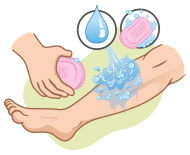 Wash the bite with soap and water as early as possible. This will help you to get rid of any bacteria that the gnat bite might have injected.
Wash the bite with soap and water as early as possible. This will help you to get rid of any bacteria that the gnat bite might have injected.- Next, apply an antiseptic cream.
- If the bite is very itchy, you can have an oral anti-itch medicine.
- You can also use an icepack to reduce the pain.
So, this was all about how to get rid of different species of gnats. We would love to hear if you have some other methods, stories, or ideas related to the topic.
Be safe and have a nice day. 🙂









